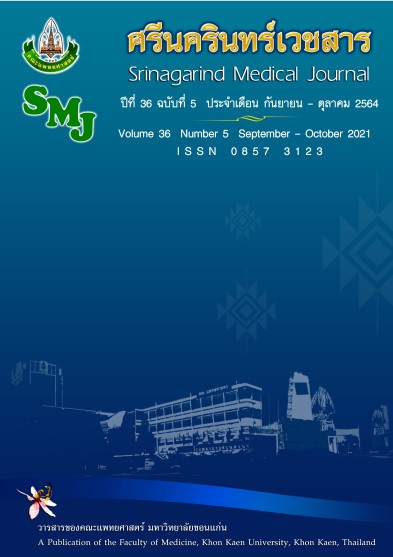ผลลัพธ์ของการบริบาลทางเภสัชกรรมโดยใช้โปรแกรม SMART AsthCOPD ในการดูแลผู้ป่วยโรคหืด
Abstract
Outcomes of Pharmaceutical Care by SMART AsthCOPD Application Program to Care Asthma Patients
Ananya Songmuang*, Thanatcha Songmuang
Department of Pharmacy, Warinchamrab Hospital
Received: 5 April 2021 / Edit: 9 July 2021 / Accepted: 4 August 2021
*Corresponding author: Ananya Songmuang, Department of Pharmacy, Warinchamrab Hospital, Warinchamrab district, Ubonratchathani province, Thailand. E-mail: ananyasongmuang@gmail.com
หลักการและวัตถุประสงค์: ปัญหาจากการใช้ยา ส่งผลให้การรักษาในโรงพยาบาลเนื่องจากหอบกำเริบเพิ่มขึ้น เดิมเภสัชกรติดตามการใช้ยาโดยใช้แบบฟอร์มกระดาษ ซึ่งอาจสูญหาย และขาดความเชื่อมโยงกับเวชระเบียนผู้ป่วย จึงมีการพัฒนาโปรแกรมคอมพิวเตอร์ชื่อโปรแกรม SMART AsthCOPD ขึ้นเพื่อแก้ปัญหา วัตถุประสงค์เพื่อ ศึกษาปัญหาจากการใช้ยาระหว่างให้บริบาลทางเภสัชกรรม ศึกษาความถูกต้องของเทคนิคการใช้ยาพ่นสูดรูปแบบ Metered Dose Inhaler (MDI) และจำนวนผู้ป่วยที่มาโรงพยาบาลเนื่องจากหอบกำเริบ ก่อนและหลังได้รับการบริบาลทางเภสัชกรรมร่วมกับการใช้โปรแกรม SMART AsthCOPD
วิธีการศึกษา: การศึกษาย้อนหลัง จากฐานข้อมูลเวชระเบียนอิเล็กทรอนิกส์ ในผู้ป่วยอายุ 18 ปีขึ้นไป ที่ได้รับการวินิจฉัยเป็นโรคหืดด้วย ICD-10 รหัส J45-J46 มารับบริการคลินิกโรคหืดผู้ใหญ่ และห้องยาคลินิกพิเศษครบ 3 ครั้ง ในช่วงวันที่ 1 ตุลาคม 2559 ถึง 30 กันยายน 2561 วิเคราะห์ผลลัพธ์ทางคลินิกตั้งแต่ 1 กันยายน 2559 ถึง 31 ตุลาคม 2561 เปรียบเทียบความแตกต่างระหว่างกลุ่มของความถูกต้องในการใช้ยาพ่นรูปแบบ MDI และการมารักษาตัวในโรงพยาบาลเนื่องจากอาการกำเริบ โดยสถิติ McNemar’s test
ผลการศึกษา: เภสัชกรสามารถติดตามการใช้ยาของผู้ป่วยครบ 3 ครั้ง จำนวน 497 ราย อายุเฉลี่ย 58.08 ± 15.25 ปี ปัญหาจากการใช้ยาที่พบมากที่สุดในผู้ป่วยกลุ่มนี้ คือ ปัญหาความร่วมมือในการใช้ยา โดยเฉพาะการใช้ยาพ่นสูดไม่ถูกต้องตามเทคนิค พบร้อยละ 44.7 ซึ่งส่วนใหญ่พ่นยาด้วยตนเองและไม่ใช้อุปกรณ์ช่วยพ่นยา การติดตามการใช้ยาพ่นสูด MDI หลังการบริบาลทางเภสัชกรรมครั้งที่ 3 พบว่าผู้ป่วยมีแนวโน้มใช้ยาพ่นสูดได้ถูกต้องทุกขั้นตอนเพิ่มขึ้นจากร้อยละ 63.0 เป็น 89.1 (p<0.001) ผู้ป่วยที่มารับการรักษาที่ห้องฉุกเฉิน และนอนโรงพยาบาล เนื่องจากอาการหอบกำเริบ ลดลงจากร้อยละ 15.3 เป็น 5.6 และร้อยละ 6.2 เป็น 3.4 ตามลำดับ อย่างมีนัยสำคัญทางสถิติ (p<0.001, p<0.001)
สรุป: การบริบาลทางเภสัชกรรมร่วมกับการใช้โปรแกรมคอมพิวเตอร์เพื่อการบริบาลทางเภสัชกรรมในผู้ป่วยโรคหืด ช่วยให้ผู้ป่วยใช้ยาพ่นสูดถูกต้องมากขึ้น อีกทั้งช่วยให้เภสัชกรสามารถติดตามแก้ไขปัญหาจากการใช้ยาของผู้ป่วยได้อย่างต่อเนื่อง รวมถึงช่วยลดการรักษาที่โรงพยาบาลเนื่องจากอาการของโรคหืดกำเริบ
คำสำคัญ: โรคหืด; บริบาลทางเภสัชกรรม; โปรแกรมคอมพิวเตอร์; SMART AsthCOPD
Background and objectives: Drug Related Problems (DRPs) lead to an increased rate of hospitalization due to asthma exacerbations. In the past, pharmacist provided pharmaceutical care using paper documentation which might lost and was not connected to an electronic medical record. Then, the SMART AsthCOPD application program was developed to solve those problems. The objectives of this study were to assess the impact of computer application on DRPs, assess the impact on the accuracy of patient technique for MDI use and the rate of hospitalization from asthma exacerbation before and after using the SMART AsthCOPD application program to care patients with asthma.
Methods: Patients aged 18 years or older with an asthma diagnosis, ICD-10 coded J45-J46 who were seen for three visits in an internal medicine adult asthma clinic and a pharmacy specialist clinic from October 1, 2016 to September 30, 2018 were included. Data of clinical outcomes were retrospectively collected from an electronic medical record from September 1, 2016 to October 31, 2018. McNemar’s test was used to compare the correctness of technique to use MDI, and hospitalization from asthma exacerbations.
Results: Of 497 patients, who were provided pharmaceutical care for three visits. The average age was 58.08 ± 15.25 years. The most commonly identified DRP in these patients was non-adherence. Incorrect MDI technique was seen in 44.7%. Most of them had no caregiver and use MDI without spacer. After the third pharmaceutical care, patients had proper MDI technique from 63.0% to 89.1% (p<0.001). The rate of emergency department visits and hospital admissions due to asthma exacerbation decreased from 15.3% to 5.6% and 6.2% to 3.4%, respectively (p<0.001, p<0.001).
Conclusion: Providing pharmaceutical care with using the computer application program significantly improves the proper technique to use MDI. Moreover, pharmacist can continuous follow-up patients with DRPs and the incidence of hospitalization due to disease exacerbation were decreased.
Keywords: Asthma; Pharmaceutical care; Computer application; SMART AsthCOPD


